Nigerian Army: Difference between revisions
→top: rv old vandalism |
|||
| Line 143: | Line 143: | ||
The government and military chiefs, working with the National Assembly, civil society and international partners, need to do much more: implement comprehensive defense sector reform, including clear identification of security challenges; a new defense and security policy and structure to address them; and drastic improvement in leadership, oversight, administration and accountability across the sector.<ref name="crisisgroup.org">{{cite web|url=https://www.crisisgroup.org/africa/west-africa/nigeria/nigeria-challenge-military-reform|title=Nigeria: The Challenge of Military Reform|date=6 June 2016|website=Crisisgroup.org}}</ref> |
The government and military chiefs, working with the National Assembly, civil society and international partners, need to do much more: implement comprehensive defense sector reform, including clear identification of security challenges; a new defense and security policy and structure to address them; and drastic improvement in leadership, oversight, administration and accountability across the sector.<ref name="crisisgroup.org">{{cite web|url=https://www.crisisgroup.org/africa/west-africa/nigeria/nigeria-challenge-military-reform|title=Nigeria: The Challenge of Military Reform|date=6 June 2016|website=Crisisgroup.org}}</ref> |
||
It currently has over 6,000 officers and 150,000 soldiers.<ref>{{Cite web |url= |
It currently has over 6,000 officers and 150,000 soldiers.<ref>{{Cite web |url=https://careersngr.com/nigerian-army-recruitment-past-questions-answers/ |title=Archived copy |access-date=13 May 2016 |archive-url=https://web.archive.org/web/20160611041920/http://www.janes.com/article/57231/nigerian-army-plans-to-double-in-size |archive-date=11 June 2016 |url-status=dead |df=dmy-all }}</ref> |
||
==Nigerian Army Recruitment== |
|||
Aside from the other functions of the Nigerian Army,the commission is also charge with the responsibility of [https://careersngr.com/nigerian-army-direct-short-service-recruitment/ enlisting] new candidates into the commission through it`s yearly [https://careersngr.com/apply-nigerian-army-recruitment-2019-79rri-trades-non-tradesmen-women/ recruitment] program that is of two type: [https://careersngr.com/nigerian-army-recruitment-2019/ regular in take] of trades/non-trades men and women recruitment and direct short service [https://careersngr.com/nigerian-army-dssc-recruitment-past-questions-answers/ recruitment]. |
|||
Meanwhile not everybody is qualified to [https://careersngr.com/nigerian-army-recruitment-past-questions-answers/ apply], if one must apply with the commission he or she must meet the Nigerian Army [https://careersngr.com/nigerian-army-dssc-recruitment/ recruitment] requirement in order to ascertain if the person can apply and after the various still wait fr the list to be [https://careersngr.com/nigerian-army-dssc-recruitment-shortlisted-candidates/ shortlisted]. |
|||
==Military forces abroad== |
==Military forces abroad== |
||
Revision as of 15:51, 11 October 2019
| Nigerian Army | |
|---|---|
 Emblem of the Nigerian Army | |
| Founded | 1960–present |
| Country | |
| Type | Army |
| Size | 200,000 (2016)[1] |
| Headquarters | Abuja |
| Motto(s) | "Victory is from God alone" |
| Engagements | Congo Crisis Nigerian Civil War First Liberian Civil War Sierra Leone Civil War Conflict in the Niger Delta Boko Haram insurgency Northern Mali War Invasion of the Gambia |
| Website | http://army.mil.ng/ |
| Commanders | |
| Commander-in-Chief | President Muhammadu Buhari |
| Chief of Army Staff | Lt General Tukur Yusuf Buratai[2] |
| Notable commanders | General Aguiyi Ironsi
General Yakubu Gowon (Retired) Lieutenant General Theophilus Danjuma (Retired) General Ibrahim Babangida (Retired) General Sani Abacha (Deceased) Major General Alwali Kazir (Retired) Lieutenant General Abdulrahman Dambazau (Retired) |
| Insignia | |
| Flag |  |
The Nigerian army (NA) is the largest component of the Nigerian Armed Forces, and is responsible for land warfare operations. It is governed by the Nigerian Army Council (NAC).[3] It bears the brunt of the nation's security challenges, notably the Boko Haram insurgency.[4]
History
The original elements of the Royal West African Frontier Force (RWAFF) in Nigeria were formed in 1900. During the Second World War, British-trained Nigerian troops saw action with the 1st (West Africa) Infantry Brigade, the 81st and the 82nd (West Africa) Divisions which fought in the East African Campaign (World War II) and in the Far East.
In Nigeria, from a force of 18,000 in infantry battalions and supporting units, strength rose to around 126,000 in three divisions by the end of the Nigerian Civil War in 1970.[5] In terms of doctrine, the task of the Federal Nigerian army did not fundamentally change: its task remained to close with and defeat an organized enemy.
The influence of individual personalities is generally greater in the armies of developing states, as they tend to have weaker institutional frameworks. Key personalities involved in Nigeria included then-Colonel Olusegun Obasanjo. Obasanjo is particularly important due to his efforts to reorganize his command, 3 Division, during the civil war to improve its logistics and administration. The reorganization he instituted made the Division capable of carrying out the offensive that ended the civil war.
The Nigerian Army fought the Civil War significantly under-resourced; Obasanjo's memoirs chronicle the lack of any stocks of extra equipment for mobilisation and the "haphazard and unreliable system of procurement and provisioning" which lasted for the entire period of the war.[6] Arms embargoes imposed by several Western countries made the situation more difficult.
At the end of the Civil War, the three divisions of the Army were reorganised into four divisions, with each controlling territories running from North to South in order to deemphasise the former regional structure. Each division thus had access to the sea thereby making triservice cooperation and logistic support easier. This deployment formula was later abandoned in favour of the present assignment of sectors to the divisions. Thus 1 Division with HQ at Kaduna is allocated the North West sector; 2 Division with HQ at Ibadan South West sector, 3 Division with HQ at Jos North East sector and 82 Division with HQ at Enugu South East sector.[citation needed]
Its formations include the 1 Division, headquartered in Kaduna in the north-west, and 2 Division (HQ Ibadan in the South-West, which includes 32 Artillery Brigade at Abeokuta).[7] 2nd Division also possibly includes 4 Brigade at Benin City, with 19 Battalion at Okitipupa and 195 Battalion at Agenebode. 52 Signal Regiment may be the divisional signals unit. 3 Division's headquarters is at Rukuba Cantonment, Jos, in the North-East, and includes 21 Armoured Brigade Maiduguri, 23 Brigade Yola, and 33 Artillery Brigades.[8] 81st Division (Amphibious) HQ in Lagos, which includes the 9 Brigade, based at the Ikeja compound in Lagos, 82nd Division (Airborne and Amphibious) HQ in Enugu in the South-East, which includes the 2 Brigade at Port Harcourt, 13 Brigade at Calabar and the 34th Artillery Brigade at Obinze/Owerri. The Composite Division at Enugu was formed in 1964 as 4 Division, in 1975 became Lagos Garrison Organization; in 1981 became 4 Composite Division; became a Composite Division in May 2002.[9] 3rd Armoured Division was responsible in 1983 for the security of areas bordering Chad.[10]
Lagos and Abuja have garrison commands, with the Lagos garrison as large as a division. 81st Division was previously the youngest division, formed on 26 May 2002 when the Lagos Garrison Command (as it then was) was upgraded to divisional status. The Division, therefore, inherited the security roles hitherto performed by the defunct Lagos Garrison Command.[11] However a later undated article in a Nigerian online newspaper says the 81st Division was later again renamed the Lagos Garrison Command. In the 1980s, the Army's brigades included the 7th Infantry Brigade in Sokoto. There are also Divisional Artillery Brigades, among which are the 32 and 34 Artillery Brigades,[12] ordnance corps units as well as Combat Engineer Regiments, and many other service support units spread across the country.
The 7th Division (also known as JTF-RO) was established in August 2013 for the war against Boko Haram. The creation of the new division brought to six the number of divisions. The 7th division is headquartered in Maiduguri.[13][13] The division includes a combat motorcycle unit as part of its 25th Task Force Brigade.[14] The purpose of this unit is stated as securing roads in Yobe and serving as a force multiplier in combat operations.[14]. Training and Doctrine Command formed in 1981, and is located at Minna. It supervises the Army's schools, including the Depot. The Army sponsors the Nigerian Military School at Zaria.
Structure
This article may require cleanup to meet Wikipedia's quality standards. The specific problem is: Article needs better organization, structure, and references. (July 2015) |
The Nigerian Army is governed by the Nigerian Army Council (NAC). The Nigerian Army is functionally organized into combat arms, which are infantry and armored; the combat support arms, which are artillery, engineers, and signals; the combat support services comprise medical, supply and transport, ordinance and finance. Others include the military police, intelligence, physical training, chaplains, public relations and band.[15] Training and Doctrine Command (TRADOC) located in Minna is responsible for doctrinal, training and combat development, and supervises training centers. There are 17 Corps Training Schools and the Nigerian Army College of Logistics (NACOL). [15][16]
The Nigerian Army said its newly created the 6th Division in Port Harcourt was established to organize and improve its internal security operations in four states of the Niger Delta. the Division will cover the Army’s 2 Brigade Akwa Ibom; 16 Brigade Bayelsa and 63rd Brigade in Delta, respectively, with divisional headquarters in Port Harcourt. This arrangement will help to curtail activities of militants, banditry, inter-communal clashes, illegal bunkering, kidnapping, robberies, Niger Delta Avengers and pipeline vandalism prevalent in the area. Insecurity in these states negatively impacts on the national economy resulting from sabotage by criminal entities within the region.[17]
Current formations include:
- 1 Division, headquartered in Kaduna[16]
- 2 Division (HQ in Ibadan)[16]
- 3 Armoured Division HQ in Jos[16]
- 6th Amphibious Division HQ Port Harcourt[17]
- 7th Infantry Division (OP-LD) HQ in Maiduguri[16]
- 8th Division HQ Sokoto[18]
- 81st Division (Amphibious) HQ in Lagos[16]
- 82nd Division (Airborne and Amphibious) HQ in Enugu[16]
- Training and Doctrine Command HQ Minna[16]
The government and military chiefs, working with the National Assembly, civil society and international partners, need to do much more: implement comprehensive defense sector reform, including clear identification of security challenges; a new defense and security policy and structure to address them; and drastic improvement in leadership, oversight, administration and accountability across the sector.[19] It currently has over 6,000 officers and 150,000 soldiers.[20]
Nigerian Army Recruitment
Aside from the other functions of the Nigerian Army,the commission is also charge with the responsibility of enlisting new candidates into the commission through it`s yearly recruitment program that is of two type: regular in take of trades/non-trades men and women recruitment and direct short service recruitment. Meanwhile not everybody is qualified to apply, if one must apply with the commission he or she must meet the Nigerian Army recruitment requirement in order to ascertain if the person can apply and after the various still wait fr the list to be shortlisted.
Military forces abroad

In December 1983 the new régime of the Head of State of Nigeria, Major General Muhammadu Buhari, announced that Nigeria could no longer afford an activist anti-colonial role in Africa. Anglophone members of the Economic Community of West African States (ECOWAS) established ECOMOG, dominated by the Nigerian Army, in 1990 to intervene in the civil war in Liberia.[21] Smaller army forces had previously carried out UN and ECOWAS deployments in the former Yugoslavia, Angola, Rwanda, Somalia, and Sierra Leone.[citation needed]
The anti-colonial policy statement did not deter Nigeria under Generals Ibrahim Babangida in 1990 and Sani Abacha in 1997 from sending peacekeeping troops as part of ECOMOG under the auspices of ECOWAS into Liberia and later into Sierra Leone when civil wars broke out in those countries. President Olusegun Obasanjo in August 2003 committed Nigerian troops once again into Liberia,[22] at the urging of the United States, to provide an interim presence until the UN's force UNMIL arrived. Charles Taylor was subsequently eased out of power by U.S. pressure[23] and exiled to Nigeria.
In October 2004, Nigerian troops were deployed into Darfur, Sudan to spearhead an African Union force to protect civilians there.[24]
In January 2013, Nigeria began to deploy troops to Mali as part of the African-led International Support Mission to Mali.[25][26]
Nigeria claimed to have contributed more than twenty thousand troops and police officers to various UN missions since 1960. The Nigeria Police Force and troops have served in places like UNIPOM (UN India-Pakistan Observer mission) 1965, UNIFIL in Lebanon 1978, the UN observer mission, UNIIMOG supervising the Iran-Iraq ceasefire in 1988, former Yugoslavia 1998, East Timor 1999, and in the Democratic Republic of the Congo (MONUC) 2004.
Nigerian Army officers have served as chiefs of defence in other countries, with Brigadier General Maxwell Khobe serving as Sierra Leone chief of staff in 1998-1999,[27] and Nigerian officers acting as Command Officer-in-Charge of the Armed Forces of Liberia from at least 2007.
Chiefs of the Nigerian Army
Following is a chronological list of officers holding the position of General Officer Commanding (GOC) or Chief of Army Staff (COAS).[28]
| Officer | Title | Period Served | Remarks |
|---|---|---|---|
| Maj Gen Kenneth G. Exham | GOC | 1956–1959 | Duke of Wellington's Regiment |
| Maj Gen Norman Foster | GOC | 1960–1962 | |
| Maj Gen John Alexander Mackenzie | GOC | 1963 | 2nd Battalion, The Lancashire Fusiliers |
| Maj Gen Sir Christopher Welby-Everard | GOC | 1963–1965 | Last British GOC |
| Maj Gen Johnson Aguiyi-Ironsi | GOC | 1965–1966 | Later military ruler |
| Lt Col Yakubu Gowon FSS | COAS | January 1966 – July 1966 | Later military ruler |
| Lt Col Joseph Akahan OFR FSS | COAS | May 1967 – May 1968 | |
| Maj Gen Hassan Katsina rcds psc | COAS | May 1968 – January 1971 | |
| Maj Gen David Ejoor | COAS | January 1971 – July 1975 | |
| Lt Gen Theophilus Danjuma | COAS | July 1975 – October 1979 | |
| Lt Gen Ipoola Alani Akinrinade CFR FSS | COAS | October 1979 – April 1980 | |
| Lt Gen Gibson Jalo CFR FSS JSS | COAS | April 1980 – October 1981 | |
| Lt Gen Mohammed Inuwa Wushishi CFR FSS | COAS | October 1981 – October 1983 | |
| Maj Gen Ibrahim Babangida | COAS | January 1984 – August 1985 | Later military ruler |
| Lt Gen Sani Abacha GCON, DSS mni | COAS | August 1985 – August 1990 | Last military ruler |
| Lt Gen Salihu Ibrahim FSS FHWC | COAS | August 1990 – September 1993 | |
| Lt Gen Aliyu Gusau Mohammed DSS rcds | COAS | September 1993 – November 1993 | |
| Maj Gen Chris Alli CRG DSS ndc psc(+) | COAS | November 1993 – August 1994?? | |
| Maj Gen Alwali Kazir DSS Usawc psc(+) | COAS | August 1994 – March 1996 | |
| Lt Gen Ishaya Bamaiyi DSS Usawc psc(+) | COAS | March 1996 – May 1999 | |
| Lt Gen Victor Malu DSS mni fwc psc | COAS | May 1999 – April 2001 | |
| Lt Gen Alexander Ogomudia | COAS | April 2001 – June 2003 | Later Chief of Defence Staff |
| Lt Gen Martin Luther Agwai | COAS | June 2003 – June 2006 | Later Force Commander of the UNAMID |
| Lt Gen Owoye Andrew Azazi | COAS | 1 June 2006 – May 2007 | Later Chief of Defence Staff |
| Lt Gen Luka Yusuf | COAS | June 2007 – August 2008 | |
| Lt Gen Abdulrahman Bello Dambazau | COAS | August 2008 – September 2010 | |
| Lt Gen Onyabor Azubuike Ihejirika | COAS | September 2010 – January 2014 | |
| Lt Gen Kenneth Minimah | COAS | January 2014 – July 2015 | |
| Lt Gen Tukur Yusuf Buratai | COAS | July 2015 – Present | Commander Multinational Joint Task Force (May 2015 – July 2015) |
Equipment
Despite a disproportionate emphasis on the materiel and sophistication of the Nigerian Armed Forces, and despite possessing some formidable hardware, the Army has been hamstrung by technical deficiency and an exceptionally poor standard of maintenance.[29] Its overabundance of foreign suppliers, including Austria, Brazil, France, Germany, Italy, Sweden, Switzerland, Romania, Turkey, Ukraine, the former Soviet Union, the United States and the United Kingdom, has also complicated logistics. Calculating the size and scope of replacement inventories alone is impossible given the menagerie of equipment in use.[29][30]
The Nigerian Army maintains at least eighty-two different weapon systems and 194 types of ammunition, of sixty-two different categories, from fourteen manufacturers.[29]
Infantry weapons
| Name | Type | Country of Origin | Notes | |||
|---|---|---|---|---|---|---|
| Handguns | ||||||
| Beretta 92[31] | 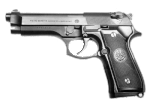
|
Semi-automatic pistol | ||||
| Beretta M1951[32] | 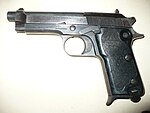
|
Semi-Automatic pistol | ||||
| Browning Hi-Power | 
|
Semi-Automatic Pistol | Some of Nigerian manufacture, designated NP-1.[33] | |||
| Walther P5[31] | 
|
Semi-Automatic Pistol | ||||
| Submachine guns | ||||||
| Beretta M12[34] | 
|
Submachine gun | Some of Nigerian manufacture.[35] | |||
| Heckler & Koch MP5[32] | 
|
Submachine gun | ||||
| Sa vz. 23 | 
|
Submachine gun | ||||
| Sten[36] | Submachine gun | |||||
| Sterling[32] | 
|
Submachine gun | ||||
| Uzi[32] | 
|
Submachine gun | ||||
| Rifles | ||||||
| IWI Tavor[37] | 
|
Bullpup assault rifle | ||||
| Beryl M762[38] | File:M762.jpg | Assault Rifle | 2000 units, some manufactured in Nigeria | |||
| FB Mini-Beryl[39] | 
|
compact assault rifle (carbine) | 10 test units (wz. 1996C)[39] | |||
| M16A1[40] | Assault Rifle | |||||
| FN FNC[32] | Assault Rifle | |||||
| Beretta AR70/90[32] | Assault Rifle | |||||
| Daewoo K2[41] | Assault Rifle | 33,000 Units have been bought | ||||
| OBJ-006 | 
|
Assault Rifle | Produced as OBJ-006.[42][43] | |||
| AKM[44] | Assault Rifle | |||||
| SIG SG 540[32] | File:SG 540 Manurhin.jpg | Battle Rifle | ||||
| NR1 | Battle Rifle | Local variant designated NR1.[45][46][47] | ||||
| Heckler & Koch G3 | 
|
Battle Rifle | Some of Nigerian manufacture.[48] | |||
| BM-59 | 
|
Battle Rifle | Some of Nigerian manufacture.[49] | |||
| Vz. 52 rifle | 
|
Semi-automatic rifle | ||||
| Machine guns | ||||||
| RPK | File:RPK Machine Gun 7.62 x 39.jpg | Light machine gun | ||||
| Degtyaryov 1938/46 | 
|
Light machine gun | ||||
| UKM-2000 | 
|
General purpose machine gun | ||||
| FN MAG | General purpose machine gun | Some of Nigerian manufacture.[35] | ||||
| Browning M2[32] | 
|
Heavy machine gun | ||||
| Sniper rifles | ||||||
| Alex-338 | 
|
Sniper rifle | ||||
Missiles and Recoilless Rifles
| Name | Type | Country of Origin | Notes | |||
|---|---|---|---|---|---|---|
| Anti-tank missiles | ||||||
| Swingfire[50] | 
|
Anti-tank missile | 100 in stock.[51] | |||
| Recoilless rifles | ||||||
| M40[4] | 
|
Anti-tank weapon | ||||
| Carl Gustav | 
|
Anti-tank weapon | 30 in service.[32] | |||
| Rocket-propelled grenades | ||||||
| RPG-7 | 
|
Anti-tank weapon | Some of Nigerian manufacture.[52] | |||
Armoured fighting vehicles
| Name | Type | Country of Origin | In Service | Notes | ||
|---|---|---|---|---|---|---|
| Main battle tanks | ||||||
| T-72 | 
|
Main Battle Tank | 77[53] | Sourced from the Czech Republic. | ||
| T-54/55 | 
|
Main Battle Tank | 24[4] | 50 delivered.[51] | ||
| Vickers Tank | 
|
Main Battle Tank | 136[4] | Mk III. | ||
| AMX-30 | 
|
Main Battle Tank | 16[4] | |||
| Reconnaissance vehicles | ||||||
| FV101 Scorpion | 
|
Reconnaissance Vehicle | 157[4] | |||
| FV107 Scimitar | 
|
Reconnaissance Vehicle | 5[4] | |||
| ERC-90 | 
|
Armoured Car | 80[54] | 40 with Lynx turret. | ||
| EE-9 Cascavel | 
|
Armoured Car | 70[4] | Delivered in 1994.[51] | ||
| Panhard AML | 
|
Armoured Car | 130[4] | AML-60 and AML-90 variants. | ||
| Saladin | 
|
Armoured Car | 16[51] | |||
| Fox | 
|
Scout Car | 55[51] | |||
| Panhard VBL | 
|
Scout Car | 72[51] | |||
| Ferret | 
|
Scout Car | 25[54] | 40 delivered.[51] | ||
| Infantry fighting vehicles | ||||||
| BMP-1 | 
|
Infantry Fighting Vehicle | 4[55] | BVP-1 variant. | ||
| Armoured personnel carriers | ||||||
| Saurer 4K 4FA | 
|
Armoured Personnel Carrier | 250[4] | 300 delivered.[54] | ||
| MT-LB | 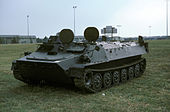
|
Armoured Personnel Carrier | 67[51] | Sourced from Poland. | ||
| Mowag Piranha I 6x6 | 
|
Armoured Personnel Carrier | 110[4] | |||
| BTR-4 | 
|
Armoured Personnel Carrier | BTR-4 with Grom module | |||
| BTR-3 | 
|
Armoured Personnel Carrier | 47[51] | BTR-3U "Guardian" variant. | ||
| BTR-70 | 
|
Armoured Personnel Carrier | 18[56] | |||
| BTR-60 | 
|
Armoured Personnel Carrier | 6[57] | |||
| Saracen | 
|
Armoured Personnel Carrier | 10[4] | 20 delivered.[51] | ||
| Saxon | 
|
Armoured Personnel Carrier | 75[51] | Serviceability doubtful.[4] | ||
| Panhard M3 | 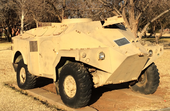
|
Armoured Personnel Carrier | 18[4] | |||
| Infantry mobility vehicles | ||||||
| Igirigi | MRAP | Replaced the Pf1.[58] | ||||
| Proforce Ara/Thunder | MRAP | Nigeria | 30 unit to be commissioned into the Nigerian army in 2019 | Proforce Nigeria | ||
| Otokar Cobra | 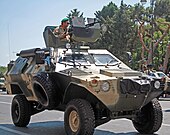
|
Multipurpose Armoured Vehicle | 204[4] | |||
| International MaxxPro | 
|
MRAP | ||||
| BAE Caiman | 
|
MRAP | ||||
| CS-VP3 | 
|
MRAP | 120 | |||
| Proforce PF1 | 
|
MRAP | RG-34 Local variant designated Proforce Pf1.[59] | |||
| Casspir | 
|
MRAP | 5[4] | Casspir III variant. | ||
| Reva | 
|
MRAP | 40[60] | Mk III.[61] | ||
| Plasan Sand Cat | 
|
Composite armored vehicle | ||||
| Light Armored Vehicles | ||||||
| SPARTAN MK.III | 
|
Light Armored Vehicle | [62] | |||
| INKAS LAPV | Light Armored Patrol Vehicle | [62] | ||||
| Shorland | 
|
Armoured Car | Mk 3.[63] | |||
| Armoured Ambulances | ||||||
| FV104 Samaritan | Tracked Ambulance | |||||
Logistics
| Name | Type | Country of Origin | In Service | Notes | |
|---|---|---|---|---|---|
| KrAZ-6322[64] | 
|
Utility Truck |
Engineering Vehicles
| Name | Type | Country of Origin | In Service | Notes | |
|---|---|---|---|---|---|
| BOZENA 5[65] | Unmanned ground vehicle | clearance of all conventional antipersonnel and antitank land mines and for IED removal assistance.[66] | |||
| Vickers AVLB [67] | Armored Bridge-layer | United Kingdom | 26 (status unknown) | ||
| Vickers ARV[67] | Armored Recovery Vehicle | United Kingdom | 12 (Status unknown) |
Utility Vehicle
| Name | Type | Country of Origin | In Service | Notes | |
|---|---|---|---|---|---|
| Pinzgauer[68] | 
|
High-Mobility All-Terrain Vehicle | |||
| Land Rover | 
|
Utility Vehicle | Some of local manufacture.[63] | ||
| Haflinger | 
|
Utility Vehicle | 400[68] | ||
| Toyota Hilux[69] | 
|
Light Truck | |||
| Tarpan Honker[70][71] | 
|
Multipurpose Jeep | 25 | ||
| IVM G-12[72] | Special Purpose Vehicles[73] |
Artillery
| Name | Type | Country of Origin | In Service | Notes | ||
|---|---|---|---|---|---|---|
| Self-propelled artillery | ||||||
| Palmaria | 
|
Self-propelled Howitzer | 25[54] | |||
| APR–40 | 
|
Multiple Rocket Launcher | 30[4] | |||
| RM-70 | 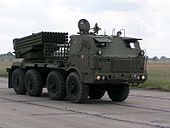
|
Multiple Rocket Launcher | 6[55] | |||
| Mortars | ||||||
| L16 | 
|
81mm Mortar | 200[54] | Some of Nigerian manufacture.[74] | ||
| Anti-tank guns | ||||||
| ZiS-3[54] | 
|
Antitank Gun | ||||
| Howitzers | ||||||
| D-30 | 
|
Howitzer | 90[51] | |||
| D-74 | Howitzer | 90[51] | ||||
| M46 | 
|
Howitzer | 7[4] | |||
| D-20 | 
|
Howitzer | 4[4] | Delivered in 1992.[51] | ||
| Haubits FH77 | 
|
Howitzer | 24[54] | |||
| OTO Melara Mod 56 | 
|
Howitzer | 124[4] | 200 delivered.[51] | ||
Air defence
| Name | Type | Country of Origin | In Service | Notes | ||
|---|---|---|---|---|---|---|
| Self-propelled anti-aircraft weapons | ||||||
| ZSU-23-4 | 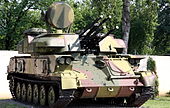
|
Self-propelled anti-aircraft gun | 30[4] | |||
| Towed anti-aircraft guns | ||||||
| Bofors L/60 | 
|
Towed anti-aircraft gun | 12[4] | |||
| ZPU[54] | 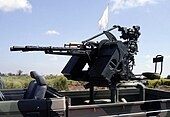
|
Towed anti-aircraft gun | ||||
| ZU-23-2 | 
|
Towed anti-aircraft gun | 350[4] | |||
| Surface-to-air missiles | ||||||
| Blowpipe | 
|
Surface-to-air missile | 48[54] | |||
| Roland | 
|
Surface-to-air missile | 16[54] | Mounted on AMX-30 chassis. | ||
| Strela 2 | 
|
Surface-to-air missile | 100[4] | |||
References
- ^ "Nigerian Army 76RRI List Of Successful Shortlisted Candidates for Zonal Screening". Livegist.com.ng. Retrieved 20 July 2018.
- ^ "Archived copy". Archived from the original on 25 July 2011. Retrieved 3 August 2010.
{{cite web}}: CS1 maint: archived copy as title (link) - ^ Parliament of Nigeria. "Nigerian Armed Forces Act, 1994" (PDF). International Red Cross. Retrieved 12 March 2015.
- ^ a b c d e f g h i j k l m n o p q r s t u v w x Guy Martin. "Nigerian Armed Forces". Defenceweb.co.za. Retrieved 15 February 2015.
- ^ Scott report, Sunday Telegraph, 11 January 1970, via N.J. Miners, The Nigerian Army 1956-65, Methuen and Co. Ltd, London, 1971, p. 229
- ^ Olusegun Obasanjo, My Command: An Account of the Nigerian Civil War, Heinemann, Ibadan/London/Nairobi, 1980, p. 61
- ^ "Home". Thisdayonline.com. Archived from the original on 15 January 2011. Retrieved 15 February 2015.
- ^ "Archived copy". Archived from the original on 13 February 2011. Retrieved 3 August 2010.
{{cite web}}: CS1 maint: archived copy as title (link) - ^ Orbat.com, Concise World Armies 2006
- ^ Jimi Peters, The Nigerian military and the state, I.B. Tauris, 1997, p. 174, via Google Books
- ^ "Archived copy". Archived from the original on 25 July 2011. Retrieved 3 August 2010.
{{cite web}}: CS1 maint: archived copy as title (link) - ^ Saxone Akhaine, Army chief decries military's involvement in politics, Guardian, Kaduna, 13 October 2008
- ^ a b John Pike. "Nigeria - 7th Infantry Division". Globalsecurity.org. Retrieved 15 February 2015.
- ^ a b "Nigerian Army Inducts Combat Motorbikes Battalion To Fight Boko Haram". Defense World. 29 February 2016. Retrieved 3 January 2017.
- ^ a b "Nigerian Army Order of Battle". www.globalsecurity.org. Retrieved 16 February 2019.
- ^ a b c d e f g h "Nigerian Army- Official Website". Army.mil.ng.
- ^ Emmanuel, Ankeli (28 November 2016). "Nigeria: Army Council Approves 8 Division for Sokoto". AllAfrica.
- ^ "Nigeria: The Challenge of Military Reform". Crisisgroup.org. 6 June 2016.
- ^ "Archived copy". Archived from the original on 11 June 2016. Retrieved 13 May 2016.
{{cite web}}: CS1 maint: archived copy as title (link) - ^ "Waging War to Keep the Peace: The ECOMOG Intervention and Human Rights (Human Rights Watch Report, June 1993)". Hrw.org. Retrieved 6 February 2017.
- ^ "Nigerian troops off to Liberia". News24. Retrieved 6 February 2017.
- ^ "CNN.com - Nigeria would shield Taylor from trial - Jul. 10, 2003". edition.cnn.com. Retrieved 2 April 2019.
- ^ "BBC NEWS | Africa | Rwandan soldiers arrive in Sudan". news.bbc.co.uk. Retrieved 6 February 2017.
- ^ "Nigeria expends N7bn on troops, logistics to Mali - Jonathan - Vanguard News". Vanguard News. 30 January 2013. Retrieved 6 February 2017.
- ^ "U.S., Africa say Mali action counters growing Islamist threat". Reuters. 23 January 2017. Retrieved 6 February 2017.
- ^ "Account Suspended". Dawodu.com.
- ^ "Archived copy". Archived from the original on 13 February 2011. Retrieved 3 August 2010.
{{cite web}}: CS1 maint: archived copy as title (link) - ^ a b c John Olukayode Fayemi. "NThreats, Military Expenditure and National Security: Analysis of Trends in Nigeria's Defence Planning, 1970 - 1990" (PDF). University of London. Archived from the original (PDF) on 12 March 2015. Retrieved 12 March 2015.
- ^ "Nigerian Army Uses Trump's Words to Justify Fatal Shooting of Rock-Throwing Protesters". Retrieved 4 November 2018.
- ^ a b Diez, Octavio (2000). Armament and Technology: Handguns. Lema Publications, S.L. ISBN 84-8463-013-7.
- ^ a b c d e f g h i Jones, Richard D. Jane's Infantry Weapons 2009/2010. Jane's Information Group; 35 edition (27 January 2009). ISBN 978-0-7106-2869-5.
- ^ Defense Industries Corporation of Nigeria Archived 27 December 2013 at the Wayback Machine Retrieved on 1 May 2013.
- ^ Gander, Jerry (2002). Jane's Infantry Weapons 2002-2003. Jane's Information Group. pp. 214, 899–906. ISBN 0-7106-2434-4.
- ^ a b Defense Industries Corporation of Nigeria Archived 18 February 2013 at the Wayback Machine Retrieved on 1 May 2013.
- ^ McNab, Chris (2002). 20th Century Military Uniforms (2nd ed.). Kent: Grange Books. ISBN 1-84013-476-3.
- ^ "Archived copy". Archived from the original on 7 January 2012. Retrieved 15 December 2016.
{{cite web}}: CS1 maint: archived copy as title (link) - ^ "Tysiąc Beryli dla Nigerii - Altair Agencja Lotnicza". Altair.com.pl. Retrieved 15 February 2015.
- ^ a b "Altair Agencja Lotnicza". Altair.com.pl.
- ^ Jane's Special Forces Recognition Guide, Ewen Southby-Tailyour (2005) p. 446
- ^ "Archived copy". Archived from the original on 14 March 2012. Retrieved 21 July 2012.
{{cite web}}: CS1 maint: archived copy as title (link) - ^ "Nigeria to mass-produce Nigerian version of AK-47 rifles." Retrieved on 5 October 2008.
- ^ "DICON – Defence Industry Corp. of Nigeria" Archived 27 December 2013 at the Wayback Machine Retrieved on 23 June 2012.
- ^ Rottman, Gordon (2011). The AK-47 Kalashnikov series assault rifles. Great Britain: Osprey Publishing. ISBN 978-1-84908-461-1.
- ^ "Licensed and unlicensed production of FN Herstal products, to August 2006" (PDF). Small Arms Survey. Archived from the original (PDF) on 5 July 2010. Retrieved 10 April 2010.
- ^ "Nigeria - Arms Procurement and Defense Industries". June 1991. Retrieved 10 April 2010.
- ^ "DOSSIER - The Question of Arms in Africa". Agenzia Fides. Archived from the original on 18 March 2009. Retrieved 10 April 2010.
- ^ Nigeria: Arms Procurement and Defense Industries. Retrieved on 5 October 2008.
- ^ German small arms: The Nigerian connection. Retrieved on 5 October 2008.
- ^ "Nigeria Armee nigeriane forces terrestres equipments vehicules blindes militaires information descr - Army Recognition". Armyrecognition.com. 14 July 2012. Retrieved 17 August 2012.
- ^ a b c d e f g h i j k l m n o "Trade Registers". Armstrade.sipri.org. Retrieved 20 April 2014.
- ^ Defense Industries Corporation of Nigeria Archived 27 December 2013 at the Wayback Machine Retrieved on 1 May 2013.
- ^ Hart, Beth (13 August 2015). "PHOTO: This Document Contains List Of Weapons Allegedly Obtained By Jonathan's Government". Naij.com. Retrieved 20 July 2018.
- ^ a b c d e f g h i j Metz, Helen Chapin. Nigeria: A Country Study. pp. 336–349.
- ^ a b Guy Martin. "Recent Nigerian military acquisitions". Webcitation.org. Archived from the original on 11 April 2015. Retrieved 30 March 2015.
- ^ "BTR-70 Report between 1992 and 2012". Deagel.com. Archived from the original on 27 April 2014. Retrieved 26 April 2014.
- ^ "The Russian BTR-60PB 8×8 Wheeled Armoured Personnel Carrier - TankNutDave". TankNutDave. Retrieved 15 February 2015.
- ^ Guy Martin. "Nigeria opens ballistic armour factory; showcases first indigenous APC". Defenceweb.co.za. Retrieved 15 February 2015.
- ^ Guy Martin. "Nigeria to unveil indigenous armoured personnel carrier". Defenceweb.co.za. Retrieved 15 February 2015.
- ^ Martin, Guy. "New vehicles join Reva lineup - defenceWeb". Defenceweb.co.za.
- ^ "Recent Nigerian military acquisitions". Revaarmoredvehicles.com. Archived from the original on 23 April 2015. Retrieved 4 May 2015.
- ^ a b "Trade Registers". armstrade.sipri.org.
- ^ a b Celestine Bassey & Charles Dokubo. Defence Policy of Nigeria: Capability and Context (2011 ed.). AuthorHouse Publishing. pp. 144–146. ISBN 978-1-4567-3156-4.
- ^ Ukrainian Defense Review. "KRAZ Trucks on Military Service". Issuu.com. Retrieved 4 May 2015.
- ^ "Nigerian army acquires more sophisticated equipment to fight Boko Haram (photos)". Naij.com. 10 December 2016.
- ^ "BOZENA 5 - medium demining system - Božena". Bozena.eu.
- ^ a b Jane's Armour and Artillery 2003–2004.
- ^ a b Constantin Kiesling. "Steyr Puch Haflinger TDC - Nigeria". Tdc.haflinger-4wd.com. Retrieved 15 February 2015.
- ^ "The Official Website of the Government of Ekiti State, Nigeria » Fayemi donates 2 Hilux pick-up to the Army". The Official Website of the Government of Ekiti State, Nigeria. Retrieved 15 February 2015.
- ^ Remigiusz Wilk [@RemigiuszWilk] (8 September 2016). "25 Honkerów w SZ Nigerii: 3 testowe, 10 Scorpion 4x4 NAF i 12 20-os. transportowe 6x4 (176 KM i 2x55 l zbiornik). Zadowoleni, chcą więcej" (Tweet) – via Twitter.
- ^ Remigiusz Wilk [@RemigiuszWilk] (10 September 2016). "Kończąc temat eksportowych Honkerów - dostarczone Skorpiony w użyciu przez jednostki ochrony lotniska @NigAirForce" (Tweet) – via Twitter.
- ^ Martin, Guy. "Nigerian Army operating locally-made IVM-G-12 special purpose vehicles - defenceWeb". Defenceweb.co.za.
- ^ "Archived copy". Archived from the original on 8 July 2017. Retrieved 19 December 2016.
{{cite web}}: CS1 maint: archived copy as title (link) - ^ Defense Industries Corporation of Nigeria Archived 27 December 2013 at the Wayback Machine Retrieved on 1 May 2013.
External links

